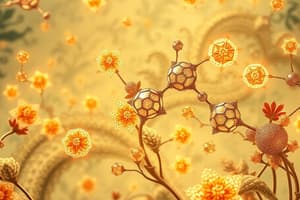Podcast
Questions and Answers
What is unique about carbon's ability to form covalent bonds?
What is unique about carbon's ability to form covalent bonds?
- It can only form triple bonds
- It can form long chains and branches with itself (correct)
- It can only form bonds with hydrogen
- It can only form single bonds
Carbon has a low melting and boiling point.
Carbon has a low melting and boiling point.
False (B)
Carbon has a high ______________ power, meaning it can form long chains and branches with itself.
Carbon has a high ______________ power, meaning it can form long chains and branches with itself.
catenation
Match the following allotropes of carbon with their descriptions:
Match the following allotropes of carbon with their descriptions:
What is the name of the system used to name carbon compounds?
What is the name of the system used to name carbon compounds?
What type of bond is indicated by the infix '-ene' in the IUPAC system?
What type of bond is indicated by the infix '-ene' in the IUPAC system?
Fullerenes are a type of carbon allotrope.
Fullerenes are a type of carbon allotrope.
What type of reaction occurs when carbon compounds react with oxygen to produce heat and light?
What type of reaction occurs when carbon compounds react with oxygen to produce heat and light?
Covalent bonds in carbon compounds are strong and ______________, leading to a wide variety of molecular shapes and structures.
Covalent bonds in carbon compounds are strong and ______________, leading to a wide variety of molecular shapes and structures.
What is the suffix in the IUPAC system used to indicate?
What is the suffix in the IUPAC system used to indicate?
Flashcards are hidden until you start studying
Study Notes
Covalent Bonds In Carbon Compounds
- Carbon forms covalent bonds with other atoms due to its ability to form four bonds.
- Carbon atoms can form single, double, or triple bonds with other atoms.
- The unique ability of carbon to form long chains and branches is due to its ability to form covalent bonds with itself.
- Covalent bonds in carbon compounds are strong and directional, leading to a wide variety of molecular shapes and structures.
Nomenclature Of Carbon Compounds
- The IUPAC system is used to name carbon compounds.
- The name of a carbon compound consists of a prefix, infix, and suffix.
- The prefix indicates the number of carbon atoms in the chain.
- The infix indicates the type of bond between the carbon atoms (e.g., -ane for single bonds, -ene for double bonds, -yne for triple bonds).
- The suffix indicates the type of functional group present in the compound.
Properties Of Carbon
- Carbon is a non-metal with a unique set of properties.
- It has a high melting and boiling point due to the strong covalent bonds between carbon atoms.
- Carbon is highly versatile and can form a wide variety of compounds with different properties.
- Carbon has a high catenation power, meaning it can form long chains and branches with itself.
Allotropes Of Carbon
- Allotropes are different forms of an element with different physical and chemical properties.
- Carbon has several allotropes, including:
- Diamond: a hard, crystalline solid with a high melting point.
- Graphite: a soft, slippery solid with a high conductivity.
- Fullerenes: a family of spherical, hollow molecules with unique properties.
- Carbon nanotubes: long, cylindrical molecules with high strength and conductivity.
Chemical Reactions Of Carbon Compounds
- Carbon compounds undergo various types of chemical reactions, including:
- Combustion reactions: carbon compounds react with oxygen to produce heat and light.
- Oxidation reactions: carbon compounds react with oxidizing agents to produce new compounds.
- Substitution reactions: one functional group is replaced with another in a carbon compound.
- Addition reactions: a functional group is added to a carbon compound, resulting in a new compound.
Covalent Bonds in Carbon Compounds
- Carbon forms covalent bonds with other atoms due to its ability to form four bonds.
- Carbon atoms can form single, double, or triple bonds with other atoms.
- Carbon's ability to form covalent bonds with itself leads to long chains and branches.
- Covalent bonds in carbon compounds are strong and directional, resulting in varied molecular shapes and structures.
Nomenclature of Carbon Compounds
- The IUPAC system is used to name carbon compounds.
- A carbon compound's name consists of a prefix, infix, and suffix.
- The prefix indicates the number of carbon atoms in the chain.
- The infix indicates the type of bond between carbon atoms (e.g., -ane for single bonds, -ene for double bonds, -yne for triple bonds).
- The suffix indicates the type of functional group present in the compound.
Properties of Carbon
- Carbon is a non-metal with unique properties.
- It has a high melting and boiling point due to strong covalent bonds between carbon atoms.
- Carbon is highly versatile, forming a wide variety of compounds with different properties.
- Carbon has a high catenation power, allowing it to form long chains and branches with itself.
Allotropes of Carbon
- Allotropes are different forms of an element with different physical and chemical properties.
- Carbon has several allotropes, including:
- Diamond: a hard, crystalline solid with a high melting point.
- Graphite: a soft, slippery solid with high conductivity.
- Fullerenes: a family of spherical, hollow molecules with unique properties.
- Carbon nanotubes: long, cylindrical molecules with high strength and conductivity.
Chemical Reactions of Carbon Compounds
- Carbon compounds undergo various types of chemical reactions, including:
- Combustion reactions: reacting with oxygen to produce heat and light.
- Oxidation reactions: reacting with oxidizing agents to produce new compounds.
- Substitution reactions: replacing one functional group with another in a carbon compound.
- Addition reactions: adding a functional group to a carbon compound, resulting in a new compound.
Studying That Suits You
Use AI to generate personalized quizzes and flashcards to suit your learning preferences.




